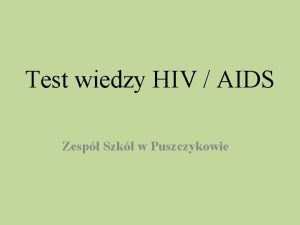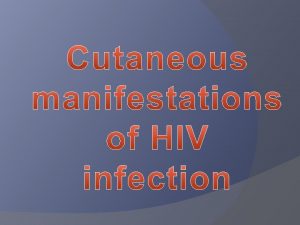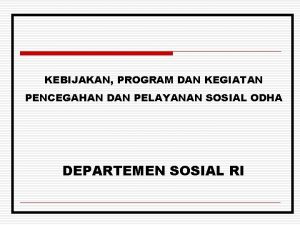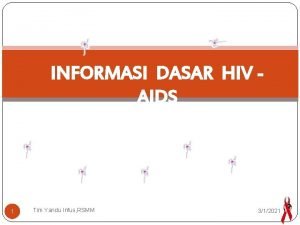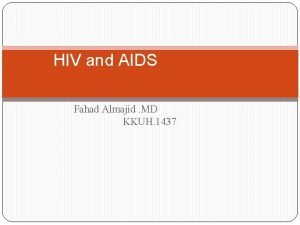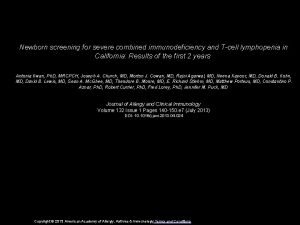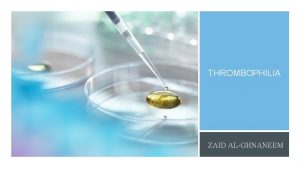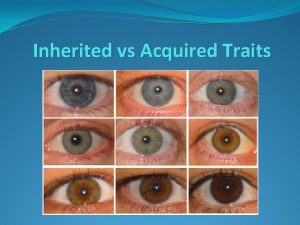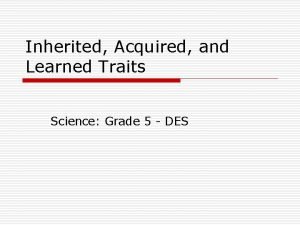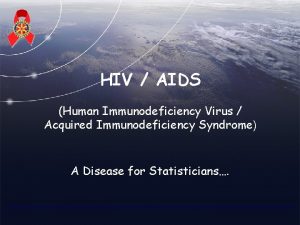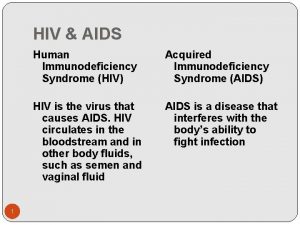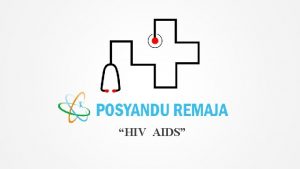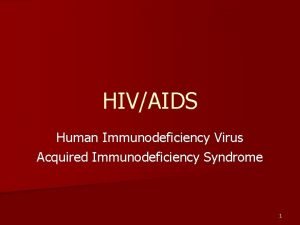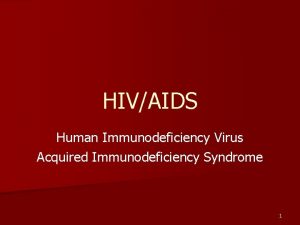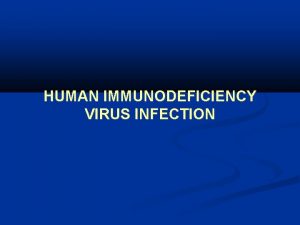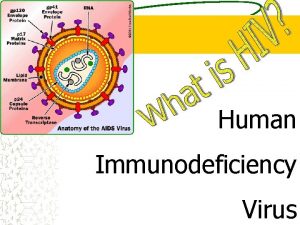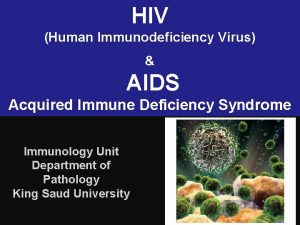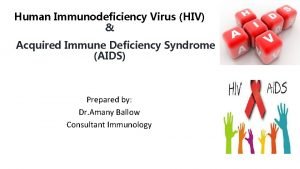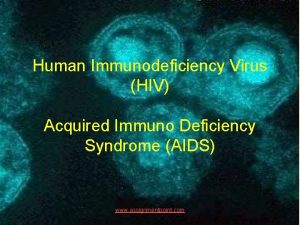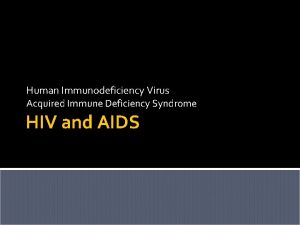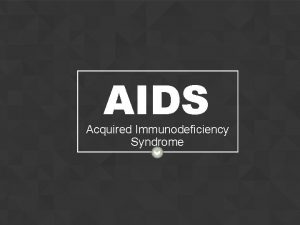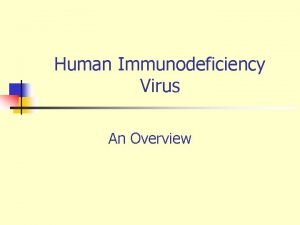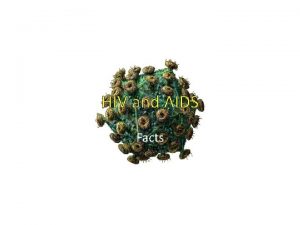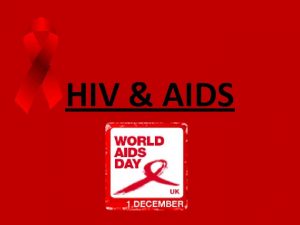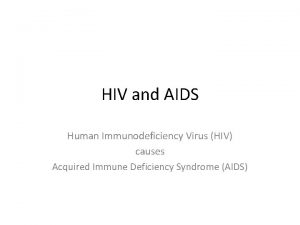Human Immunodeficiency Virus HIV Acquired immunodeficiency Syndrome AIDS






















- Slides: 22

Human Immunodeficiency Virus (HIV) & Acquired immunodeficiency Syndrome (AIDS) By: Prof. Dr. Ghada Fahmy Helaly UGS Module Prof. Dr. Ghada Fahmy Helaly

Disease: v. Acquired immunodeficiency syndrome (AIDS). v. HIV-1 worldwide, HIV-2 West Africa. Important Properties: Ø HIV is Retroviruses (lentivirus). Ø HIV infects and kills helper (CD 4) T lymphocytes loss of CMI opportunistic infections. Ø Macrophages and monocytes can be infected also. Prof. Dr. Ghada Fahmy Helaly

Characteristics: *Bar-shaped core *Envelope (gp 120 and gp 41). *The genome: two copies (diploid) of a single-stranded, positivepolarity RNA genome *Typical retroviral genes: gag, pol, and env the structural proteins. *Two regulatory genes, tat and rev replication, Four, accessory genes: nef, vif, vpr, and vpu. Prof. Dr. Ghada Fahmy Helaly

*The gag gene “core” proteins (p 24). *The pol gene encodes: * Reverse transcriptase. * Integrase. * Protease. *The env gene gp 160, a precursor glycoprotein two envelope glycoproteins, gp 120 and gp 41. *Antigenicity of the gp 120 protein changes rapidly many serotypes. Prof. Dr. Ghada Fahmy Helaly

*Tat protein activates viral transcription. *Tat and Nef protein repress the synthesis of class I MHC proteins reducing the ability of cytotoxic T cells to kill HIV-infected cells. *rev, controls the passage of late m. RNA from the nucleus into the cytoplasm. Prof. Dr. Ghada Fahmy Helaly

(1) gp 120 and gp 41 are the typespecific envelope glycoproteins. *gp 120 protrudes from the surface and interacts with the CD 4 receptor. *gp 41 is embedded in the envelope and mediates the fusion of the viral envelope with the cell membrane at the time of infection. Prof. Dr. Ghada Fahmy Helaly

*Antibody against gp 120 neutralizes the infectivity of HIV, but gp 120 variants no effective vaccine. The high mutation rate may be due to lack of an editing function in the reverse transcriptase. (2) The group-specific antigen, p 24, is located in the core. Antibodies against p 24 do not neutralize HIV infectivity but serve as important serologic markers of infection. Prof. Dr. Ghada Fahmy Helaly

*The natural host : humans, primates. Chimpanzees living in West Africa were the source of HIV-1 “jumping the species barrier. ” *Two other similar retroviruses: 1. HIV-2 : AIDS patients in West Africa in 1986. The proteins of HIV-2 are 40% identical to HIV-1, less transmissible than HIV-1. 2. SIV : monkeys with an AIDS-like illness. The proteins resemble those of HIV-2. Prof. Dr. Ghada Fahmy Helaly

HIV Replication Cycle Prof. Dr. Ghada Fahmy Helaly

Prof. Dr. Ghada Fahmy Helaly

HIV replication is dependent on cell proteins as well as viral proteins: *Gag and Pol polyproteins viral protease. *Env polyprotein cellular protease. *The Gag : p 24, p 17, and several smaller proteins. *The Pol : Reverse transcriptase, Integrase, and Protease. Prof. Dr. Ghada Fahmy Helaly

* Transmission: *Sexual contact. *Infected blood reduced by screening donated blood. *Perinatal transmission. *Needle-stick injuries. *Intravenous drug users (IVDU). Prof. Dr. Ghada Fahmy Helaly

* Pathogenesis & Immunity: The initial infection of the genital tract occurs in dendritic cells local CD 4 - helper T cells. HIV is first found in the blood 4 to 11 days after infection. Targets Th 17 cells infections by bacteria. Infects brain monocytes and macrophages syncytia. HIV “superantigen, ” activates many helper T cells and leads to their death. Prof. Dr. Ghada Fahmy Helaly

Prof. Dr. Ghada Fahmy Helaly

HIV has three main mechanisms by which it evades the immune system: (1) Integration of viral DNA into host cell DNA (2) High rate of mutation of the env gene (3) Production of the Tat and Nef proteins that down-regulate class I MHC proteins Prof. Dr. Ghada Fahmy Helaly

* Clinical Findings: 2 to 4 weeks after infection, a mononucleosis-like picture, maculopapular Rash, Leukopenia, CD 4 cells is usually normal, A high-level viremia lower level of viremia and a rise in the number of CD 8 T cells Prof. Dr. Ghada Fahmy Helaly

*Antibodies 10 to 14 days up to 3 to 4 weeks after infection. *The lower limit of CD 4 count considered as normal is 500 cells/mm 3. The frequency and severity of opportunistic infections below 200/μL. Prof. Dr. Ghada Fahmy Helaly

§ Long (7 to 11 y). §The patient is asymptomatic. § viremia is low or absent. § Large amount of HIV lymph nodes. A syndrome called AIDS-related complex (ARC) : Persistent fevers, fatigue, weight loss, and lymphadenopathy. ARC often progresses to AIDS. Prof. Dr. Ghada Fahmy Helaly

an increase in the frequency and severity of opportunistic infections. Pneumocystis pneumonia and Kaposi’s sarcoma. Bacterial, Viral, Fungal and Protozoal infections. Prof. Dr. Ghada Fahmy Helaly

* Laboratory Diagnosis: Detecting antibody with ELISA. Western blot as confirmatory test. Determine the “viral load” PCR. Ora. Quick is a rapid screening immunoassay for HIV antibody p 24 antigen test or viral culture. Prof. Dr. Ghada Fahmy Helaly

* Treatment: *Nucleoside analogues, such as zidovudine, lamivudine inhibit reverse transcriptase. *Non-nucleoside inhibitors of reverse transcriptase. *Protease inhibitors. *A fusion inhibitor, and binding inhibitor. *Highly active antiretroviral therapy (HAART). *Treatment of the opportunistic infection. * Prevention: * No vaccine. *Avoid exposure to the virus (e. g. , using condoms, not sharing needles). *Screening of blood. *Cesarean section. *Circumcision reduces HIV infection. Prof. Dr. Ghada Fahmy Helaly

Thank You Prof. Dr. Ghada Fahmy Helaly
 Test wiedzy o hiv
Test wiedzy o hiv A bacterial std that usually affects mucous membranes
A bacterial std that usually affects mucous membranes Chapter 24 sexually transmitted diseases and hiv/aids
Chapter 24 sexually transmitted diseases and hiv/aids Causative organism of hiv/aids
Causative organism of hiv/aids Chapter 17 oral pathology short answer questions
Chapter 17 oral pathology short answer questions Kasus hiv aids
Kasus hiv aids Virus hiv
Virus hiv Hiv virus
Hiv virus Monocyte derived dendritic cells
Monocyte derived dendritic cells Severe combined immunodeficiency
Severe combined immunodeficiency Acquired thrombophilia
Acquired thrombophilia Ptt levels
Ptt levels Milstrip
Milstrip Texas date acquired
Texas date acquired Plants are sessile
Plants are sessile Inherited vs acquired traits
Inherited vs acquired traits Examples of acquired traits
Examples of acquired traits Aquired trait
Aquired trait Learned traits examples
Learned traits examples Acquired physical traits
Acquired physical traits Acquired traits in plants
Acquired traits in plants Acquired traits
Acquired traits Systemic acquired resistance in plants
Systemic acquired resistance in plants
